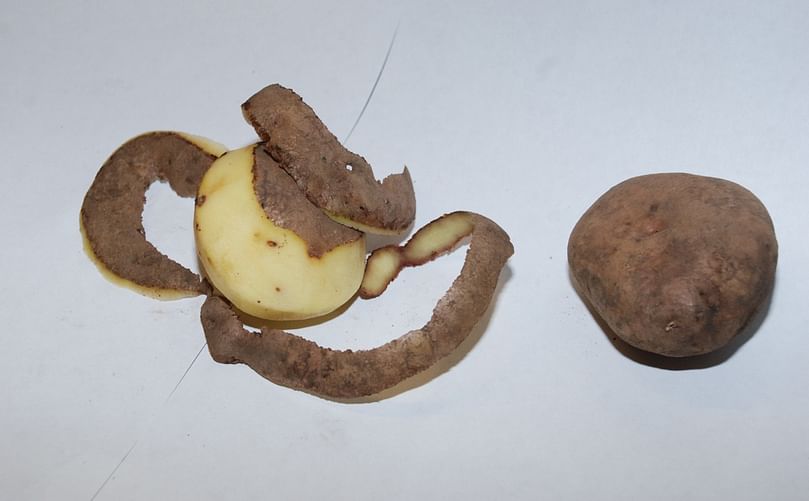主标签
Models would help estimate nutrients required by potato crops

The study characterised the consumption and distribution of calcium, magnesium and sulfur in different potato varieties. (Courtesy: Unimedios archive).
Through four experimental studies in two production cycles, for the first time it was possible to develop the "critical dilution curves" of calcium (Ca), magnesium (Mg) and sulfur (S) in cultivars (several crops) of potato, which which represents a contribution to diagnose if the crop is at an adequate, deficient or excessive level of concentration of these nutrients.
Kristal Castellanos Ruiz, Master in Agricultural Sciences from the National University of Colombia (UNAL):
"Statistical models generated for each nutrient and each crop allow potato growers to determine the nutritional need for these elements and make corrections at any point in the crop cycle, which would improve tuber yield and quality while making more efficient use of resources."This is maintained by the researcher Kristal Castellanos Ruiz, who sought to characterise the consumption and distribution of calcium, magnesium and sulfur in potato (Solanum tuberosum L., andigena subspecies) Diacol Capiro and Pastusa Suprema varieties in two localities of the Cundiboyacense highlands with climatic conditions and contrasting soil.
As mineral nutrients, calcium, magnesium and sulfur have a direct impact on potato tuber yield and quality. Frequently, there are problems of over or under dosage in crops, which negatively affect their yield and quality.
For example, calcium deficiency generates various physiological disorders, such as the appearance of internal brown spots, cracks and hollow hearts, which seriously affect the quality of the tuber, while magnesium deficiency generates a decrease in the content of starch and sugars, in the mechanical resistance of the tuber, discoloration of the pulp and appearance of internal black spots.

Calcium deficiency generates various physiological disorders, such as the appearance of internal brown spots, cracks and hollow hearts.
"Faced with this problem, diagnostic tools are needed to make the nutritional management of calcium, magnesium and sulfur in potatoes more efficient and effective. For this, four field experiments were established in two production cycles, in the localities of Facatativá (high fertility soils) and Chocontá (low fertility soils)."Advance in knowledge of nutrients
"We evaluated two cultivars (Diacol Capiro and Pastusa Suprema) and two fertilization levels (0 and 100% of the recommended dose of essential macro and micronutrients). We measured the dry biomass of the plant and the content of calcium, magnesium and sulfur in tubers and in the aerial part from the formation of the main stems to the maturation of the tuber."
"We were able to better characterize the behavior and the genotype-environment interaction of the potato cultivar with the locality, determining that Diacol Capiro has greater plasticity to adapt to contrasting soil and climate conditions, since it behaved very well in both localities, while the supreme pastusa presented a better adaptation to the locality of Chocontá."
"Throughout the production cycle, it was also very important to establish the specific needs for calcium, magnesium, and sulfur at the critical stages of the crop that we sampled, which include the formation of primary stems, secondary stems, flowering, and the beginning of tuberization, the maximum tuberization and tuber maturation."
Potato yield and quality components are directly related to proper nutritional management of major and minor elements.
However, research on potato nutrition has focused on the major elements such as nitrogen (N), phosphorus (P) and potassium (K), with little knowledge about secondary macronutrients, very important for the crop, such as calcium, magnesium and sulfur.
Most of the calcium is found in leaves and stems, and to a lesser extent in tubers, which are more likely to suffer from a deficiency of this element, even in soils with high content and availability of this.
For this reason, by increasing the concentration of calcium in the tuber, it is possible to significantly reduce the appearance of physiological disorders, mechanical damage to the harvest and the incidence of pests and diseases.
For its part, an adequate magnesium supplement is essential for the yield and quality of the tuber, especially if the potato is destined for industrial processing.
Although it has been considered that potato cultivation has low consumption of sulfur, its deficit is reflected in a low use of nitrogen, phosphorus and potassium, in addition to lower dry weight in the tubers and low content of amino acids, especially cysteine and leucine.
Like to receive news like this by email? Join and Subscribe!
Get the latest potato industry news straight to your WhatsApp. Join the PotatoPro WhatsApp Community!
精选企业
Sponsored Content
Sponsored Content
Sponsored Content
Sponsored Content








